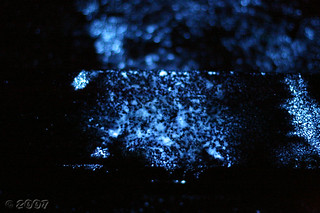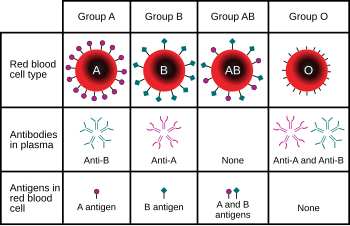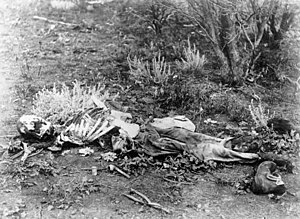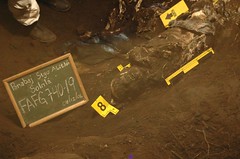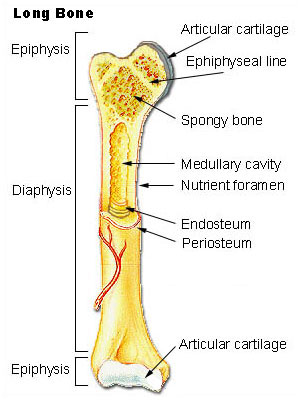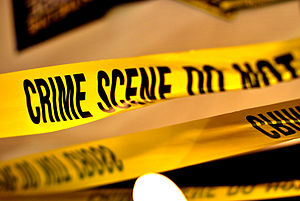| (Photo credit: Wikipedia |
(CSI blog link)
Serology is simply the study of bodily fluids.
These fluids include:
* Blood
* Semen
* Saliva
* Sweat
* Tears
* Vomit
* Vaginal secretions
These fluids can be found either on the skin or transferred to another surface.
While serology tests can EXCLUDE a subject who is thought to be a person of interest, it can not find them culpable.
Serology tests are class studies and cannot tie a body fluid to a specific and unique source.
Only DNA testing can link a specific individual to a crime. (DNA blog link)
from evidence and make false conclusions about the scene
Is there blood present but not visible to the naked eye?
* Fluorescein - precursor to Luminol goes back to 1900s
`Is not thwarted by chlorine bleach
` Uses UV light to glow
`Still used in the field today
`Thicker than Luminol so good for
vertical surfaces
* Luminol/BlueStar
`Does not work if chlorine bleach
was used to clean up the blood
`Complicates further testing by
diluting the blood
`Needs darkness
When you write a scene that includes either of these tests, please remember that the blood is not visible to the naked eye because it was cleaned up. When the blood was cleaned, it was smeared around. The Luminol or Fluorecein will show up in smear streaks NOT blood spatter. NOT hand prints.
Video Quick Study (2:49) Shows luminescence of BlueStar
Is that blood? Testing for a visible stain:
* Leucomalachite Green
Video Quick Study (4:28)
* Kastle-Meyer test - phenolthaline and hydrogen
peroxide that detects the hemoglobin in blood
cells.
`produces a dark pink.
`blood can come from any animal
Video Quick Study (1:01)
Video Quick Study (7:41) CSI teacher shows how the three presumptive blood tests are conducted.
Once the presumptive tests show that a substance is blood then the collection is sent to the lab where they undergo confirmatory tests:
1. Is it human blood?
* The serology labs have stocks of antigens that are found in animals but not humans.
* Samples of common animals such as: dog, cat, rabbit, deer, chicken etc. antigens are maintained for
testing.
* If the test shows an antigen reacting with an antibody then that determines the species type.
2. Once it is determined that the blood is human then blood test typing is done.
* Blood Type
`ABO system
`Rh Protein (not used in forensic science)
`Genetically inherited
`Can be determined not just from
blood but also from other body secretions.
` Blood type is class evidence. It is NOT
individuating evidence. So it can only be
used to show that someone COULD NOT
have done the crime but cannot be used to
prove that some did - that would require
DNA
Video Not Quite So Quick Study (14:00) Goes over this thoroughly if it is an important point in you plot and you need a firm grasp on the importance of blood typing.
* Can be found in a dead woman's body for up
to two weeks
* In a living sexual assault victim sperm can only
be found for about five hours after the crime
occurs
* After 72 hours in a live victim there may be no
remaining evidence of sperm or semen
* Acid phosphatase is a presumptive field test.
Acid Phosphate is made in the seminal
vesicles in males but also in:
`non-human animals
`plants and fungi
`found in vaginal fluids.
* Microscopic search for sperm cells in a
sample is a confirmatory test
* Microscopic sperm search is NOT useful if
the man has had a vasectomy
* PSA (Prostate-specific Antigen) is considered
confirmatory
Video Quick Study (1:01) Acid Phosphatase Test
Video Quick Study (3:15) Storage and container information for serology samples
Video Quick Study (2:31) Serologist at trial giving testimony - note the packaging of the items
Using various wave length light sources to find bodily fluids at a crime scene
All body fluids fluoresce except for blood which absorbs light
Body fluids must be dry to fluoresce except for urine (which will sometime fluoresce when wet)
Video Quick Study (2:00)
Serology tests are class studies and cannot tie a body fluid to a specific and unique source.
Only DNA testing can link a specific individual to a crime. (DNA blog link)
Presumptive tests - likelihood of something being what you think it is in the field.
* Sometimes a false positive - but you never want a false negative because then a detective could walk awayfrom evidence and make false conclusions about the scene
Is there blood present but not visible to the naked eye?
* Fluorescein - precursor to Luminol goes back to 1900s
`Is not thwarted by chlorine bleach
| Blood Stained Floorboard Treated with Luminol (Photo credit: Jack Spades) |
`Still used in the field today
`Thicker than Luminol so good for
vertical surfaces
* Luminol/BlueStar
`Does not work if chlorine bleach
was used to clean up the blood
`Complicates further testing by
diluting the blood
`Needs darkness
When you write a scene that includes either of these tests, please remember that the blood is not visible to the naked eye because it was cleaned up. When the blood was cleaned, it was smeared around. The Luminol or Fluorecein will show up in smear streaks NOT blood spatter. NOT hand prints.
Video Quick Study (2:49) Shows luminescence of BlueStar
Is that blood? Testing for a visible stain:
 |
| At FBI doing serology tests |
Video Quick Study (4:28)
* Kastle-Meyer test - phenolthaline and hydrogen
peroxide that detects the hemoglobin in blood
cells.
`produces a dark pink.
`blood can come from any animal
Video Quick Study (1:01)
Video Quick Study (7:41) CSI teacher shows how the three presumptive blood tests are conducted.
Once the presumptive tests show that a substance is blood then the collection is sent to the lab where they undergo confirmatory tests:
1. Is it human blood?
* The serology labs have stocks of antigens that are found in animals but not humans.
* Samples of common animals such as: dog, cat, rabbit, deer, chicken etc. antigens are maintained for
testing.
* If the test shows an antigen reacting with an antibody then that determines the species type.
2. Once it is determined that the blood is human then blood test typing is done.
* Blood Type
| Diagram of ABO blood groups and the IgM antibodies present in each. (Photo credit: Wikipedia) |
`Rh Protein (not used in forensic science)
`Genetically inherited
`Can be determined not just from
blood but also from other body secretions.
` Blood type is class evidence. It is NOT
individuating evidence. So it can only be
used to show that someone COULD NOT
have done the crime but cannot be used to
prove that some did - that would require
DNA
Video Not Quite So Quick Study (14:00) Goes over this thoroughly if it is an important point in you plot and you need a firm grasp on the importance of blood typing.
Semen
| Sperm (album) (Photo credit: Wikipedia) |
to two weeks
* In a living sexual assault victim sperm can only
be found for about five hours after the crime
occurs
* After 72 hours in a live victim there may be no
remaining evidence of sperm or semen
* Acid phosphatase is a presumptive field test.
Acid Phosphate is made in the seminal
vesicles in males but also in:
`non-human animals
`plants and fungi
`found in vaginal fluids.
* Microscopic search for sperm cells in a
sample is a confirmatory test
* Microscopic sperm search is NOT useful if
the man has had a vasectomy
* PSA (Prostate-specific Antigen) is considered
confirmatory
Video Quick Study (1:01) Acid Phosphatase Test
Video Quick Study (3:15) Storage and container information for serology samples
Video Quick Study (2:31) Serologist at trial giving testimony - note the packaging of the items
Using various wave length light sources to find bodily fluids at a crime scene
All body fluids fluoresce except for blood which absorbs light
Body fluids must be dry to fluoresce except for urine (which will sometime fluoresce when wet)
Video Quick Study (2:00)



